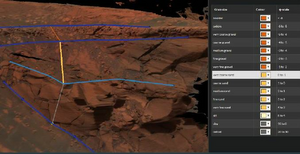Information
- Publication Type: Master Thesis
- Workgroup(s)/Project(s):
- Date: August 2021
- Date (Start): 9. October 2019
- Date (End): 9. August 2021
- TU Wien Library:
- Diploma Examination: 9. August 2021
- Open Access: yes
- First Supervisor: Eduard Gröller

- Pages: 133
- Keywords: visual analytics, 2D-3D integration
Abstract
In recent years, digital outcrop models have become a popular tool to carry out geological investigations on the computer. These high-resolution, 3-dimensional models of outcrops are also created for the exploration of Mars. With specialized software, geologists can annotate geological attributes on digital outcrop models, such as the boundaries between di˙erent rock layers. After annotating, geologists create logs, a graphic description of the rock layers. To establish a geological model of a larger region, corresponding layers are correlated in multiple logs. The correlated layers of the logs are graphically linked in a correlation panel. Creating correlation panels is very time-consuming, and they are usually created by hand with drawing programs. Due to this restriction, the diagrams are created at the end of the interpretation process to avoid time-consuming editing afterwards. When switching to a drawing program, the connection between the original data and the encoded data in the diagram is also lost. This work is part of a design study with the aim of automating the creation of correlation panels, and turning a static illustration into an interactive application that can be integrated into the interpretation process. In this work, after a short introduction to the exploration of Mars with the help of geology, we analyse published correlation panels to explore the design space of these illustrations. In addition to that analysis we conducted workshops and a research stay at Imperial College London with our domain collaborators. Using the information gained from the analysis and our collaborators, we describe possible design choices, and extract the minimum requirements for a prototype. The prototype created in the course of this work was later extended and presented in a paper that encompasses the whole design study.
Additional Files and Images
Additional images and videos
Additional files
Weblinks
BibTeX
@mastersthesis{Nowak_2021,
title = "Interactive Correlation Panels for the Geological Mapping of
the Martian Surface",
author = "Rebecca Nowak",
year = "2021",
abstract = "In recent years, digital outcrop models have become a
popular tool to carry out geological investigations on the
computer. These high-resolution, 3-dimensional models of
outcrops are also created for the exploration of Mars. With
specialized software, geologists can annotate geological
attributes on digital outcrop models, such as the boundaries
between di˙erent rock layers. After annotating, geologists
create logs, a graphic description of the rock layers. To
establish a geological model of a larger region,
corresponding layers are correlated in multiple logs. The
correlated layers of the logs are graphically linked in a
correlation panel. Creating correlation panels is very
time-consuming, and they are usually created by hand with
drawing programs. Due to this restriction, the diagrams are
created at the end of the interpretation process to avoid
time-consuming editing afterwards. When switching to a
drawing program, the connection between the original data
and the encoded data in the diagram is also lost. This work
is part of a design study with the aim of automating the
creation of correlation panels, and turning a static
illustration into an interactive application that can be
integrated into the interpretation process. In this work,
after a short introduction to the exploration of Mars with
the help of geology, we analyse published correlation panels
to explore the design space of these illustrations. In
addition to that analysis we conducted workshops and a
research stay at Imperial College London with our domain
collaborators. Using the information gained from the
analysis and our collaborators, we describe possible design
choices, and extract the minimum requirements for a
prototype. The prototype created in the course of this work
was later extended and presented in a paper that encompasses
the whole design study.",
month = aug,
pages = "133",
address = "Favoritenstrasse 9-11/E193-02, A-1040 Vienna, Austria",
school = "Research Unit of Computer Graphics, Institute of Visual
Computing and Human-Centered Technology, Faculty of
Informatics, TU Wien",
keywords = "visual analytics, 2D-3D integration",
URL = "https://www.cg.tuwien.ac.at/research/publications/2021/Nowak_2021/",
}

 image
image Master Thesis
Master Thesis Poster
Poster


